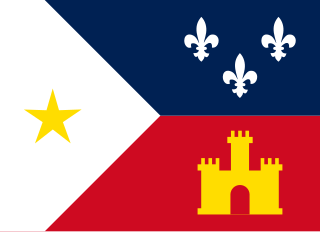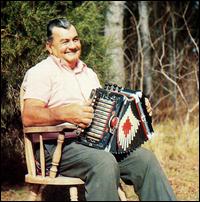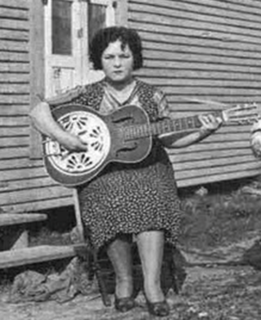
A fais do-do is a Cajun dance party; the term originated before World War II.

A fais do-do is a Cajun dance party; the term originated before World War II.
According to Mark Humphrey, the parties were named for "the gentle command ('go to sleep') young mothers offered bawling infants." [1] He quotes early Cajun musician Edwin Duhon of the Hackberry Ramblers:
"Do-do" itself is a hypocoristic shortening of the French verb dormir (to sleep), used primarily in speaking to small children. The phrase is embodied in an old French lullaby, a song sung to children when putting them down for the night.
Joshua Caffery, however suggests the true derivation is more plausibly the dance call dos à dos (back to back), the do si do call of Anglo-American folk dance; and that sources such as Duhon are merely "repeating the same apocryphal explanation known by almost anyone who lives in Southern Louisiana." [2]
Occurrences include the following:

The Cajuns, also known as Acadians, are an ethnic group mainly living in the U.S. state of Louisiana. They also live in the Canadian maritimes provinces consisting in part of the descendants of the original Acadian exiles—French-speakers from Acadia (L'Acadie) in what are now the Maritimes of Eastern Canada. In Louisiana, Acadian and Cajun are often used as broad cultural terms without reference to actual descent from the deported Acadians. Historically, Louisianians of Acadian descent were also considered to be Louisiana Creoles, although Cajun and Creole are often portrayed as separate identities today. Most Cajuns are of French descent. The Cajuns make up a significant portion of south Louisiana's population and have had an enormous impact on the state's culture.
The music of Louisiana can be divided into three general regions: rural south Louisiana, home to Creole Zydeco and Old French, New Orleans, and north Louisiana. The region in and around Greater New Orleans has a unique musical heritage tied to Dixieland jazz, blues, and Afro-Caribbean rhythms. The music of the northern portion of the state starting at Baton Rouge and reaching Shreveport has similarities to that of the rest of the US South.

Cajun music, an emblematic music of Louisiana played by the Cajuns, is rooted in the ballads of the French-speaking Acadians of Canada. Although they are two separate genres, Cajun music is often mentioned in tandem with the Creole-based zydeco music. Both are from southwest Louisiana and share French and African origins. These French Louisiana sounds have influenced American popular music for many decades, especially country music, and have influenced pop culture through mass media, such as television commercials.
Swamp pop is a music genre indigenous to the Acadiana region of south Louisiana and an adjoining section of southeast Texas. Created in the 1950s by young Cajuns and Creoles, it combines New Orleans–style rhythm and blues, country and western, and traditional French Louisiana musical influences. Although a fairly obscure genre, swamp pop maintains a large audience in its south Louisiana and southeast Texas homeland, and it has acquired a small but passionate cult following in the United Kingdom, Northern Europe, and Japan.

Michael Louis Doucet is an American singer-songwriter and musician best known as the founder of the Cajun band BeauSoleil.

Rod Bernard was an American singer who helped to pioneer the musical genre known as "swamp pop", which combined New Orleans-style rhythm and blues, country and western, and Cajun and black Creole music. He is generally considered one of the foremost musicians of this south Louisiana-east Texas idiom, along with such notables as Bobby Charles, Johnnie Allan, Tommy McLain, and Warren Storm.

The term Creole music is used to describe both the early folk or roots music traditions of rural Creoles of Louisiana.

Joseph Denton "Jay" Miller was an American record producer, musician and songwriter from Crowley, Louisiana, whose Cajun, swamp blues, and swamp pop recordings influenced American popular culture.

Cajun English, or Cajun Vernacular English, is the dialect of English spoken by Cajuns living in Southern Louisiana. Cajun English is significantly influenced by Louisiana French, the historical language of the Cajun people, a subset of Louisiana Creoles—although many today prefer not to identify as such—who descend largely from the Acadian people expelled from the Maritime provinces during Le Grand Dérangement. It is derived from Louisiana French and is on the list of dialects of the English language for North America. Louisiana French differs, sometimes markedly, from Metropolitan French in terms of pronunciation and vocabulary, partially due to unique features in the original settlers' dialects and partially because of the long isolation of Louisiana Creoles from the greater francophone world.

Nathan Abshire was an American Cajun accordion player. His time in the U.S. Army inspired Abshire to write the crooner song "Service Blues", which the newspaper Daily World reported as "one of his most memorable tearjerkers". After the war, he settled in Basile, Louisiana, where he played regularly at the Avalon Club. He released his best-known record, "Pine Grove Blues", in 1949. Abshire's music became more well known outside of Louisiana at the 1964 Newport Folk Festival. Abshire was never able to write so he was unable to sign autographs, resulting in him having to politely decline the requests. Despite thoughts of Abshire being "arrogant or stuck-up" for not signing autographs, he was unable to read and write. However, Abshire was taught how to write his own signature by Barry Jean Ancelet. Despite receiving more income from music than the majority of Cajun musicians, Abshire was not able to entirely depend on that income to live on. Abshire had multiple jobs during his life and his final job was working as the custodian of the town's dump. Abshire's legacy continued after his death in the form of a museum, a book, and a magazine special issue.

Joseph Falcón was an accordion player from southwest Louisiana, best known for producing the first recording of a Cajun song, "Allons à Lafayette," in 1928. He and his wife Cléoma Breaux left for New Orleans to record the first Cajun record and went on to perform across southern Louisiana and Texas.

Ann Savoy is a musician, author, and record producer.

Cajun music has its roots based in the ballads of the French-speaking Acadians of Canada, and in country music.
The Grammy Award for Best Zydeco or Cajun Music Album was an honor presented to recording artists at the 50th, 51st, 52nd and 53rd Annual Grammy Awards (2008–2011) for quality zydeco or cajun music albums. The Grammy Awards, an annual ceremony that was established in 1958 and originally called the Gramophone Awards, are presented by the National Academy of Recording Arts and Sciences of the United States to "honor artistic achievement, technical proficiency and overall excellence in the recording industry, without regard to album sales or chart position".

Cléoma Falcon was an American guitarist and vocalist who, along with her husband Joe Falcon, recorded one of the first known examples of Cajun music. The recording, "Allons à Lafayette" was released in 1928, and opened the way for other commercial releases of Cajun music. Aside from being a ground-breaking recording artist, Cléoma Breaux also was one of the few women to perform live, despite the social standards of the era.
The culture of Louisiana involves its music, food, religion, clothing, language, architecture, art, literature, games, and sports. Often, these elements are the basis for one of the many festivals in the state. Louisiana, while sharing many similarities to its neighbors along the Gulf Coast, is unique in the influence of Cajun culture, due to the historical waves of immigration of French-speaking settlers to Louisiana. Likewise, African-American culture plays a prominent role. While New Orleans, as the largest city, has had an outsize influence on Louisiana throughout its history, other regions both rural and urban have contributed their shared histories and identities to the culture of the state.

Breaux Frères or Breaux Brothers, were Cajun musicians. They were the earliest to record the song "Jolie Blonde", under the title of "Ma Blonde Est Partie".
Jean Duet "Dewey" Segura was an American folk musician. He and his brother Edier Segura formed the duo known as the "Segura Brothers". The duo created some of the earliest Cajun music in the late 1920s.

Oran "Doc" Guidry was an American Cajun and country music fiddler. Some of his best known recordings include "Wondering", "Colinda", "Crowley Two Step", and "Chere Cherie".
| Look up dodo#French in Wiktionary, the free dictionary. |